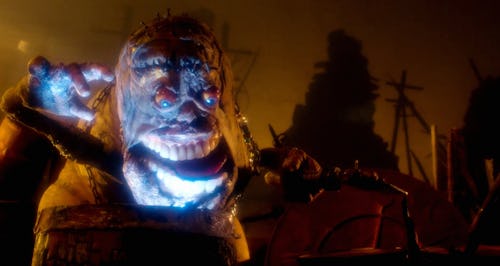
The 70-year-old Academy Award winner appears on the Zoom call clad in a cutoff T-shirt and haloed within a beam of sunlight.
Phil Tippett’s shock-white hair and beard add to the celestial aura, an image the stop-motion animation legend responsible for iconic designs of Star Wars, RoboCop, and Jurassic Park would likely find amusing. After all, he’s spent the past three decades painstakingly constructing his own vision of Hell, an undertaking that led him to a mental breakdown.
“It just burned me out and put me in the psych ward. It took me a while to recover,” he says during our conversation. “It really was this [Joseph] Campbellian Hero’s Journey, like [Carl] Jung did with his Red Book. When artists are obsessed, you can tell, and it can really take you to some dark places.”

Tippett was institutionalized for roughly a week and subsequently diagnosed with unipolar depression soon after completing Mad God, his much-anticipated horror saga that garnered a cult following years before it was ever even released. Now, after three decades, Tippett’s completed work is finally available on the horror streaming platform, Shudder — and as often as this sentiment is used, please just trust me when I say that you haven’t seen anything remotely like it.
“The project exhausted me and transformed me, obviously. And I will never, ever make another film like that,” he vows.
Magnum Opus
It’s obvious from the movie’s first frames that Mad God is Tippett’s magnum opus — a surreal, ambitious, laborious mix of stop motion, live actors, and go motion animation (now an industry-standard technique Tippett co-developed and popularized over 40 years ago).
The plot is deliberately vague: An unnamed explorer referred to as “The Assassin” descends via diving bell into a post-apocalyptic hell populated by fleshy automaton armies, cleaver-wielding mutant brothel madams, and behemoths engaged in perpetual battle. From there, it only gets weirder. Bile, blood, viscera, waterfalls of feces; you name it, it probably gets splattered across the screen at some point during The Assassin’s explorations.
A movie this mindbogglingly intensive could never be completed alone but, thankfully, Tippett received aid from numerous coworkers, artists, and fans over the years to help both construct and film Mad God’s intricate sequences and character interactions. “I was lucky enough to get a lot of volunteers, and [with] Kickstarter and friends lending me money and whatnot, I was able to complete it,” he says. Even with that assistance, Tippett devoted thousands of hours in starts and fits over the years to constructing mountains of melted army men, mechanical plague doctors, and wailing monstrosities built from real human dentures and hair. “It’s a pretty boilerplate answer, but they’re all like your children,” he responds when I ask if he has a favorite creature.
“I will never, ever make another film like that.”
For a movie requiring so much methodical, behind-the-scenes planning and preparation, it somewhat ironically is also one that purposefully doesn’t spend time worrying about logic, clearly defined narrative, or explicit symbolism.
“It happened pretty naturally, you know? One thing leads to the next. I don’t work by intention, I work primarily from my unconscious. That’s my guide. I have faith in it, and it tells me what to do,” he explains of his creative process. As such, viewers are encouraged to feel out Mad God as opposed to breaking down each vignette and character. Descriptors like “grim,” “grotesque,” and “What the hell did I just watch?” frequently come to mind while watching Tippett’s hallucinatory journey. But, oddly enough, there are certainly moments of — dare I say it — hope.
“I always have hope. I mean, you don’t have anything else, even if it’s in the last moments of your life,” he says. “It’s a wonderful and a cruel world out there, and you’ve got to embrace both.” Tippett says that Mad God was his attempt to find that balance between the wondrous and the cruel. “The [film] is very much influenced by Hieronymus Bosch. It’s filled with horrible, demonic stuff but also whimsy, you know? Visions of Heaven.”
Clock Versus Time
The latter section of Tippett’s Mad God also clearly touches the ways one experiences and contends with the notion of time itself — a theme that’s perhaps unavoidable and unsurprising coming from someone whose life’s work centers on the slow, incremental stills that combine to depict fluid movement.
“The older I get, studying time, observing time in the simplest things — I’m always amazed by it, you know? In a simple walk to the grocery store, what happens in [that] experience?” he reflects. “It’s like an adventure, it’s almost as if I don’t know where I am. By the time I get back, I’m usually absorbed in some [other] thought, and it’s just like, ‘I’m home! It’s a miracle!’” Tippett says, laughing. “Time is very mercurial. I really enjoy time.”
In the years before, during, and after Mad God (he’s already gearing up for another mysterious animated project, Pequin's Pendiquen) Tippett has often raced to meet countless deadlines, both personal and professional. Now, with Mad God and the movie’s positive and negative personal effects behind him, perhaps Tippett can enjoy more of those mercurial moments.
“You’re working against the clock all the time, [so] you have an innate sense of the clock,” he says of his career. “But that ain’t ‘time.’”







